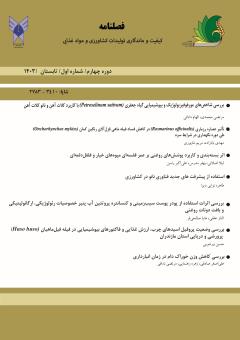بررسی کاهش وزن خوراک دام در زمان انبارداری
محورهای موضوعی : ماندگاری فراورده های غذایی و تولیدات کشاورزیعلی اصغر صادقی 1 , زهره رهنمایی 2 , مرتضی ندافی 3 *
1 - دانشیار، گروه علوم دامی، واحد علوم و تحقیقات، دانشگاه آزاد اسلامی، تهران، ایران
2 - دانشیار، گروه ریاضی، واحد فیروزکوه، دانشگاه آزاد اسلامی، تهران، ایران
3 - کارشناس ارشد، شرکت پشتیبانی امور دام، تهران، ایران
کلید واژه: نهادههای دامی, کاهش وزن, انبار,
چکیده مقاله :
در کشور ایران، ذرت، جو و کنجاله سویا، سه نهاده اصلی و پرمصرف در تغذیه دام میباشند. وزن این دانهها در حین ذخیره کردن در انبارها مقداری کاهش مییابد که تحت تأثیر عواملی نظیر نوع نهاده، نوع انبار (سیلو، سوله و روباز چادری) و نیز مدتزمان نگهداری میباشد. در انبارداری نهادههای دامی، برآورد مقدار متعارف کاهش وزن در مدتزمان نگهداری برای انبارداران و صاحبان کالا اهمیت دارد. در این تحقیق مقدار کاهش وزن دانه ذرت، جو و کنجاله سویا بر اساس نوع انبار، مدت و استان محل نگهداری با استفاده از دادههای مربوط به انبارهای شرکت پشتیبانی امور دام در سالهای 1395 تا 1402 بررسی شد. تأثیر نوع انبار و مدتزمان نگهداری دانه ذرت و جو در انبار در تغییرات کاهش وزن معنیدار بود (01/0< P). بیشترین کاهش وزن در انبار سیلو و کمترین آن در انبار روباز بود. تأثیر اقلیم و مدتزمان نگهداری کنجاله سویا در انبار در تغییرات کاهش وزن معنیدار بود (01/0< P). بیشترین کاهش وزن کنجاله سویا در اقلیم گرم و خشک و سپس گرم و مرطوب و کمترین آن در منطقه بارانی بود. بنابراین، بهمنظور بهینهسازی نگهداری و کاهش ضررهای اقتصادی، بایستی کشاورزان و مدیران انبارها از انبارهای مناسب استفاده کنند و شرایط اقلیمی را در انتخاب محل انبار و مدتزمان نگهداری موادغذایی مدنظر قرار دهند. این نتایج میتواند به بهبود مدیریت انبارها و کاهش هزینههای ناشی از کاهش وزن محصولات کمک کند.
The corn, barley and soybean meal are the three widely used feeds in animal nutrition in Iran. During the storage of feedstuffs in warehouses, there is some weight loss, which is because of type of storage (silo, niches, and open warehouse), as well as the duration of storage. Estimation of weight loss during storage is important for the owners of the feedstuffs. In this research, the weight loss of corn, barley and soybean meal estimated according to the type of storage, duration and the province in which the storage is located. The data of weight loss supplied by the State Livestock Affairs Logistics from 2015 to 2023. The effect of the type of storage and duration of storage, on corn and barley weight loss were significant (P<0.01). The highest weight loss in terms of storage type was seen in silo storage and the lowest in open storage. The effect of climate and storage time of soybean meal on weight loss was significant (P<0.01). The weight loss in terms of storage time in all three feeds was highest in 12 months and more. The highest weight loss of soybean meal was in hot and dry climate and then in hot and humid climate and the lowest was in rainy region. To optimize storage and minimize economic losses, farmers and warehouse managers should utilize appropriate storage facilities and take climatic conditions into account when selecting storage locations and durations for food products. These findings can enhance warehouse management practices and lower costs associated with product weight loss.
1. Miandoabchi E, Aghajani Z. Strategic reserves of agricultural products: a comparative study of the experiences of Asian countries and offering suggestions for Iran. Commercial Surveys. 2021;19(106):91-102.
2. Alizadeh P, Mohammadi H, Shahnoushi N, Saghaian Nejad SH, Pooya A. Investigating factors affecting import demand of meat and livestock inputs in Iran. Agricultural Economics. 2019 ;13(3):1-28.
3. Ziegler V, Paraginski RT, Ferreira CD. Grain storage systems and effects of moisture, temperature and time on grain quality-A review. Journal of Stored Products Research. 2021; 91:101770.
4. Bhardwaj S, Sharma R. The challenges of grain storage: A review. International Journal of Farm Sciences. 2020;10(2):18-22.
5. Tilley DR, Casada ME, Subramanyam B, Arthur FH. Temporal changes in stored-product insect populations associated with boot, pit, and load-out areas of grain elevators and feed mills. Journal of Stored Products Research. 2017; 73:62-73.
6. Molenda M, Montross MD, Horabik J, Ross IJ. Mechanical properties of corn and soybean meal. Transactions-American Society of Agricultural Engineers. 2002 ;45(6):1929-36.
7. Omodara MA, Montross MD, McNeill SG, Bessin R. Impact of storage environment on the micro-climate and grain moisture in polypropylene storage bags. In2020 ASABE Annual International Virtual Meeting 2020 (p. 1). American Society of Agricultural and Biological Engineers.
8. Sugri I, Yeboah O-A, Bidzakin JK, Naanwaab C, Nutsugah SK, Kombiok JM. Participatory on-farm evaluation of some storage methods and grain protectants on quality characteristics of maize (Zea mays L.). American Journal of Experimental Agriculture. 2014;4(11):1268.
9. Zorya S, Morgan N, Diaz Rios L, Hodges R, Bennett B, Stathers T, Mwebaze P, Lamb J. Missing food: the case of postharvest grain losses in sub-Saharan Africa.
10. Masoudian SA. Climatic regions of Iran. Geography and development. 2003; 2: 171-184 [In Persian].
11. Ailbakhshi H, Dourandish A, Sabouhi M. Investigating the Effects of Climate Change on Agricultural Market in Semi-arid Regions. Journal of Agricultural Economics and Development. 2020 ;34(2):127-48 [In Persian].
12. Kasmai M. Climate Architecture: Khak Publications;2003.
13. https://gtc.ir/index.aspx?fkeyid=&siteid=1&pageid=1104&p=1&showitem=23
14. Alabi JO, Fafiolu AO, Oso AO, Jegede AV, Dada ID, Teniola AA, Oluwatosin OO. Physico-chemical and compositional changes in proprietary finished feeds stored under different conditions. Archivos de zootecnia. 2017;66(256):535-41.
15. Cheng M, McCarl B, Fei C. Climate change and livestock production: a literature review. Atmosphere. 2022 ;13(1):140.

